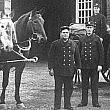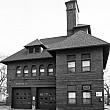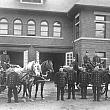
New Engine House at Chester and Diamond
New Engine House
“The new station to be known in the Grand Rapids Fire Department as No. 11, which is situated on Diamond Street, has been completed to the last item by the contracting firm of Hayden & Appleyard, and awaits only the official acceptance of the Board of Public Works to make the building an addition to the property of the City of Grand Rapids. The structure and its furnishings have been complete about ten days, and the contractors expected the Board of Public Works would look over the structure last Thursday and accept the work at the regular meeting last week.
The building will house one steam fire engine, to be drawn by two horses, and one light hose wagon, containing something more than a thousand feet of hose. The latter vehicle was built at the repair shop in connection with No. 3 Engine House on Front Street, and is in every way a model hose wagon. The department now has a reserve steamer, which will probably be placed in the Diamond Street house, but it will be necessary to purchase four new horses. Officers for the house will be secured either by transfer from other companies, or by promotion from the rank and file and, unless the plans of the Board of Police and Fire Commissioners miscarry, the new station should be fully equipped, manned and in active commission long before the snow of the next winter flies.
The new house with its apparatus will fill a long-felt want. Practically the whole East End, which is so situated as to command pressure from the reservoir and standpipe, is so high that the pressure is way below what it should be for fire protection, and in the South End, territory which will be covered by the apparatus from the Diamond Street house, the distance is so great from the pump house and reservoirs that the pressure is totally inadequate. Another good feature about the location of No. 11 house is the fact that quick service may be had with the apparatus on the hill. The machines from the center of the city, or any other part of the city, have very heavy grades to climb which stand in the way of quick runs with the heavy vehicles of the department, while the machines from the new house will have no grades to interfere with a record run to any part of the higher section of the city. The hills will also be in favor of the Diamond Street apparatus in case of a conflagration down town, which would call out the steamer.
There is a determined effort being made on the part of the colored residents to have the new house manned by colored men. The board has been looking into the matter for some time, and find that the principal objection lies in the matter of substitutes. The men at No. 11 house, if they are colored, cannot stay on duty continuously, and the board is inclined to think that it would hardly be a paying venture to keep a substitute on hand for the one house alone. The matter of officers who could be secured to live with and command a colored crew for the apparatus in another item to be considered by the board and whether colored mechanics sufficiently skilled to look after the intricate machinery of the steamer can be secured is also in doubt.
The drafts for the crew at the new house will probably be made within two weeks, and as soon as the house is accepted by the Board of Public Works requisition for the purchase of the movable furnishings of the house will be made by the Board of Police and Fire Commissioners.”
Grand Rapids Press, August 16, 1902, page 2
Retired fire department captain Robert Imhoff explains the remark above that "if they are colored, cannot stay on duty continuously." The men were allowed a day off periodically and substitutes filled in but were not regular firemen (when a vacancy occurred a substitute may have been hired permanently). I believe the city fathers felt that not enough African Americans could be obtained to provide enough substitues, and the regular fireman could not stay on duty continuously. Also, at that time, the firemen were required to live near their Engine House so they could answer alarms when they were home for an hour for meals three times a day. Not everyone was allowed to go home for meals at once--they rotated, and some firemen did not eat breakfast until 10 AM or later.
- November 1, 1902, Engine House #11 at 1002 Chester Street S.E. (at the corner of Diamond Avenue S.E.) is put into commission.
- November 11, 1950—David T. King is hired (effective November 28th) as the city’s first African-American firefighter and at the date of his retirement, July 2, 1984, he had attained the rank of Equipment Operator—another African-American male was hired on November 11, 1950, but did not complete training and quit the department.
- In 2013, Engine House #11 (now known as Chester Street Fire Station) is the oldest active fire station in the Grand Rapids Fire Department.
Read the prior article about appointing African American fire fighters.
Contributed by retired Capt. Robert Imhoff of the Grand Rapids Fire Department

 facebook
facebook




